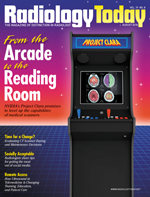 MRI Monitor: A Matter of Protocol: FDA-Approved MRI Enhancement Reduces Scan Time, Increases Resolution
MRI Monitor: A Matter of Protocol: FDA-Approved MRI Enhancement Reduces Scan Time, Increases Resolution
By Eyal Aharon
Radiology Today
Vol. 19 No. 8 P. 8
Both CT and MRI techniques are common, and, consequently, patients usually have some knowledge of each. The type of scan is dictated by radiologists based on the clinical query, the patient's condition, and urgency. Generally, MRI is useful for capturing very small details in soft tissues, joints, ligaments, and tendons and is commonly used to scan the spine, neck, and brain. CT scans are more useful for diagnosing serious injuries, such as trauma to the chest and/or abdomen and heart failure.
Although CT is a painless, fast, and relatively cheap method for obtaining medical images, it is still advisable to carefully weigh the benefits of a specific CT scan before performing it, to minimize radiation exposure and the risk of radiation-related complications. Since its development in the 1970s, MRI has proven to be a highly beneficial imaging technique with sublime clinical capabilities; MRI exams allow the utmost diagnostic accuracy with minimal side effects and without exposing the patient to the ionized radiation that is emitted by X-ray or CT.
Radiation in CT and scan time in MRI are equivalent in affecting image quality. In MRI, longer acquisition time results in higher signal-to-noise ratio (SNR), better image quality, and fewer artifacts. Similarly, in CT, higher radiation dose provides better SNR and better images.
Effects of Time Reduction
Whereas the flaw of CT scans is radiation exposure, the drawbacks of MRI scans are its long acquisition time and related high cost. Due to its long acquisition time and the need for patients to stay motionless within a narrow, loud-banging MRI bore, MRI is still considered an expensive and unfriendly procedure. The lack of mobility, which makes MRI scans almost unbearable to some patients, is required because movement disrupts the image capture process, which may result in repeat scans and an even longer time within the scanner. A routine MRI scan can range between 20 minutes and two hours, making the procedure especially hard for young children and many patients who experience a claustrophobic reaction during the exam. Reducing MRI scan times without sacrificing quality can improve patient care while increasing utility and cost-effectiveness.
A recent study presented at the American Society of Neuroradiology meeting in Vancouver, British Columbia, Canada, by Lawrence N. Tanenbaum, MD, FACR, shows that a novel machine learning-based iterative image reconstruction algorithm developed by Medic Vision (iQMR) can enable significant reduction of 30% in brain MRI scan times, with no impairment of the image quality and clinical value. The study, conducted in multiple locations in the United States and Israel, evaluates image quality, grey-white (GW) matter differentiation, and overall diagnostic sufficiency of brain MRI images acquired with reduced scan-time protocols that are processed with the iQMR, compared with images from sites' routine protocols.
Under Institutional Review Board-approval, 37 subjects were scanned on three 1.5 T scanners (Philips Healthcare's Ingenia, Siemens Healthineers' Aera, and GE Healthcare's Signa-HDx), at three different sites using the site's routine clinical brain protocols as well as time-reduced variants that were 30% shorter, on average, than the sites' routine brain exam. The short scans were prescribed by changing conventional acquisition parameters, such that the revised setting traded scan time reductions for decreased SNR. Images acquired by short scans were processed by iQMR and compared to standard "full time" images by six neuroradiologists. The reviewers conducted an independent, blinded, side-by-side comparison of diagnostic quality, visual image quality, GW-matter differentiation, and presence of artifacts. The reviewers found that the iQMR-processed short-scan images were substantially equal to the standard images in all parameters.
The iQMR technology, recently cleared by FDA, was launched May 15, and is now available to support all MRI scanners of all vendors and models.
— Eyal Aharon is CEO of Medic Vision Imaging Solutions.

